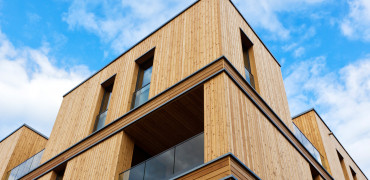In the new era of green construction, we need to be asking ourselves how sustainable is concrete?
It holds us together, provides our infrastructure, our schools, our homes. But the major component of concrete is of course cement.
The cement industry is not only one of the primary producers of carbon dioxide but concrete also causes damage to the most fertile layers of the earth, the topsoil.
Next to coal-powered electricity, the manufacture of cement is the next biggest emitter of greenhouse gases accounting for approximately 5% of the annual global CO2 production.
There are several manufacturing processes and technologies that can reduce the impact of the cement industry in construction but what if we want to look further than that, towards true alternatives?
Our building methods need to reflect a greener, more sustainable future.
House of straw
Rather than solely relying on new research and technology, straw bale building reflects the days when buildings were constructed from natural, locally occurring materials.
The bales are used to form a frame, replacing the need for concrete or stone. When sealed and treated properly, straw bales naturally provide very high levels of insulation for both hot and cold climates.
It is not only an affordable building product but highly sustainable and renewable.
Grasscrete is a method of laying flooring. It is a concrete framework that provides walkways, driveways, recreational areas. The open pattern allows grass or other forna to grow. This method not only reduces the amount of concrete needed but the open framework cleverly provides improved storm water absorption and drainage. The overall aesthetic is also improved and the huge slabs of continuing grey are reduced
Compressed dirt
Rammed Earth is nothing more than dirt tamped down very tightly in wooden forms. It has a similar feel to concrete and literally cannot be more natural.
It is a technology that has been used in construction and by human civilisation for thousands of years. It is long lasting and sustainable. Modern rammed earth buildings can be made more structural by the use of bamboo and mechanical tampers reduce the labour cost.
This method of construction has been neglected as a useful technique for decades now but it is increasingly experiencing a renaissance in global architecture.
Hemp
Hempcrete is a concrete like material created from the woody inner fibres of the hemp plant. The fibres are bound with lime to create concrete like shapes that are strong and lightweight.
Hempcrete blocks dramatically reduce the energy needed for transportation, they are super light and can be packed tightly.
Hemp itself is a fast growing renewable source. It is a bio-composite material which can be used in both construction and insulation. It is easier to work with than traditional lime and also acts as a moisture regulator.
It lacks the brittleness of traditional concrete and therefore forgoes the need for expansion joints.
Building with Hempcrete is comparable to the cost of constructing with concrete. Hempcrete will eventually turn to petrified rock and will last for hundreds of years.
Fast growing
Bamboo has actually been used as a locally sourced building material in some regions of the world for millennia. It is a promising combination of the following. It is a strong, lightweight and fast growing renewable source.
It can be used successfully for framing buildings and constructions.
Bamboo can replace the expensive and heavy imported building materials and provides a valid alternative to concrete.
Fungus
Mycelium is a futuristic building material that none of us have probably ever heard of!
It is totally natural and originates from the root structure of fungi and mushrooms. Mycelium can be encouraged to grow around a composite of other natural materials like straw, and in moulds or forms.
These forms can then be air-dried to create lightweight, strong blocks or bricks. There are already construction companies exploring the vast properties of mycelium.
The root network provides a fast growing matrix that then has the capability as acting like a natural glue. The material can be grown locally, close to the construction site and all the while the mycelium absorbs carbon. Any waste is of course compostable!
Plastic
Recycled plastic is being used by researchers to create a concrete made up of ground up recycled plastics and rubbish.
This method not only reduces greenhouse gas emissions but reduces both weight and waste. It provides a new use for landfill clogging waste.
The traditional
Wood still retains many advantageous properties over the industrial building materials like concrete.
Not only do the trees absorb CO2 as they grow but they require much less energy-intensive methods to process into useful construction products.
Forests provide a renewable source of materials and provide the benefits that come with a bio diverse habitat.
Recycling
Ferrock is also a new material being increasingly researched. It uses recycled materials including steel dust. It is used to create a concrete-like building material that is even stronger than concrete.
The advantages don’t stop there, this unique material actually absorbs and traps carbon dioxide as part of its drying and hardening process, making it not only less CO2 intensive but actually carbon neutrals.
Similarly Ashcrete is another alternative. By using the ash, a by-product of burning coal 97% of traditional components of concrete can be replaced with this recycled material.
In summary
So in the crusade to cut global CO2 emissions how can we not consider the above?
Our attention now needs to cover not only power plants and cars but also building materials and the construction industry.
Our architecture and building methods need to reflect a greener, more sustainable future. Our future generations will demand the change.
Kirsty Hammond is editor and publisher of Specifier Review, which posts building product and project news



